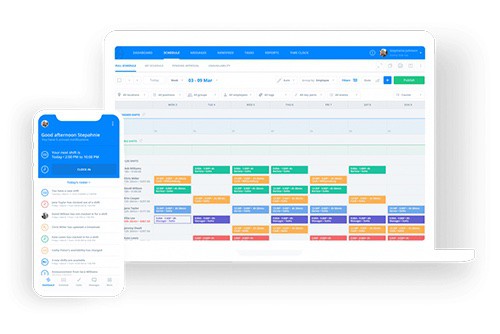5 Employee Training Methods And How To Implement Them
At first glance, you may think that employee training is all about teaching your...

Scheduling for schools can be a complicated process. There are so many variables to contend with that it may seem almost impossible to create a productive and efficient schedule for your teachers and students.
With a few guiding principles in mind and the right tools at your disposal, you’ll be able to build a timetable that ticks all the boxes.
In this article, we discuss the principles that affect your master schedule and how you can go about building a plan that’s good for everyone involved.

With regards to scheduling for schools, personalized learning has been trending upward in the last few years thanks to the idea that advising students should be more than just support and planning for career or college come junior and senior year.
Advisory now includes activities such as:
Institutions of all types and sizes — primary, secondary, and post-secondary — are beginning to build personalized learning blocks into their schedules to provide the support their students need to excel.
In many areas of education, programming a school day doesn’t depend quite as much on funneling students from classroom to classroom until the final period.
Scheduling for schools now incorporates out-of-classroom and alternative options, including:
Because of this shift from a more traditional model of learning where students spend their time moving from one classroom and teacher to another, administrators would do well to build the master schedule with flexibility in mind.
Ensuring that resources are available — whether they’re used or not — is a key component in making many of the out-of-classroom and alternative options possible for both students and teachers.

A big part of scheduling for schools involves considering both the academic and the social-emotional strengths of each student and then balancing classes accordingly.
This guiding principle benefits both teachers and students by:
Building a schedule with balanced class composition in mind goes a long way toward improving the learning atmosphere for students and the work environment for teachers and staff.
In the past, administrators that engaged in scheduling for schools largely neglected the importance of providing time for teacher collaboration and planning. But that is starting to change.
As more and more schools move toward empowering students to take control of their own learning decisions, teachers need more prep time than ever before.
They have to be ready to organize and lead many of the alternative learning options mentioned earlier in this article — e.g., community outreach, real-world projects, and student-to-student collaboration — as well as the more traditional classroom-based curriculum.
Creating a master schedule with collaboration and planning as core components gives teachers the time they need to develop a class curriculum that will facilitate the learning of the students in their charge.

In some cases, it can take weeks — and even months — to create a master schedule that’s good for teachers and students alike. If you wait until the last minute to begin putting things on paper, you can easily run out of time.
Start early in the summer and give yourself at least an hour of uninterrupted time at each sitting to consider the best structure and arrangement for the next school year.
If you finish the program in a week or two, you’ve got the remainder of the break to tweak it and make it even better. But, if you find the organization process more difficult than you thought, you’ll have plenty of time to give the timetable the attention it needs.
One of the nice things about scheduling for schools is that you don’t have to start from scratch. You have the previous year’s plan to build on.
Use that schedule as a template, but don’t just copy and paste. Examine the schedule and ask yourself what worked and what didn’t. If a portion of the plan worked, keep it for next year. If a portion of the plan didn’t work, get rid of it and try something else.
By basing new rotas on past rotas, you constantly improve the master schedule. With a little hard work and persistence, eventually, you may even build the perfect agenda for your team.
As you analyze last year’s schedule, ask questions that will help you improve.
Of course, you’ll need to start with fundamental questions, such as:
After you’ve established the basics, you can move on to more complicated questions and topics (some of which we’ll discuss later on in this article) that will help you build a better schedule for your teachers and students.

In years past, scheduling for schools involved complicated spreadsheets that required hours of setup and formatting before you could get to arranging classes.
Some administrators even went old-school and relied on whiteboards or blank walls filled with Post-it Notes to organize their thoughts.
Though they may have been around for a long time, none of those solutions are particularly well-suited for scheduling even one or two people, let alone an entire school’s worth.
Modern technology has changed all that.
Scheduling software was built to bring order to the chaos of organizing multiple individuals in multiple time slots over multiple days. When you use technology meant for scheduling, you won’t have to force a square peg into a round hole.
Once you’ve analyzed the previous year’s schedule and found the right software with which to build your roster, take some time to consider your teacher’s needs.
This is also the perfect time to refresh your memory on state, city, and district requirements. For example, in New York, NY, every teacher must have at least one preparation period and a duty-free lunch.
These requirements and teacher needs will certainly come into play when you start adding names to your school schedule.
Another important step in scheduling for schools is asking for teacher feedback before setting things in stone. Be prepared for all kinds of suggestions — some good, some bad — and be sure to inform teachers beforehand that you won’t be able to accommodate them all.
That said, you may find small changes that can really make a difference in your master schedule.
Take this hypothetical as an example: One school had scheduled the younger students (e.g., the kindergarten and some of the lower elementary grades) in the first of three lunch periods.
Teachers noticed that these students often ate slower than those in higher grades, causing delays and overlap in the transitions back to class.
They brought this up in a staff meeting, and the administration moved the younger students’ lunch break to the third period (with a snack to get them through) so that they didn’t interfere with other parts of the schedule.

As we’ve mentioned throughout this article, technology plays an important role in all scheduling for schools. With tools like Sling, building a teacher and staff rota is easier than it’s ever been.
The Sling suite of tools is built to make scheduling as simple, straightforward, and streamlined as possible without forcing you to engage in a lot of unnecessary formatting before you can start assigning classes.
Try Sling for free and discover just how easy it is to create a schedule of any size that keeps your school running smoothly from the beginning of the year to the end.
For more resources to help you manage your organization, coordinate and schedule your team, track work time, and control labor costs, visit GetSling.com today.
See Here For Last Updated Dates: Link
This content is for informational purposes and is not intended as legal, tax, HR, or any other professional advice. Please contact an attorney or other professional for specific advice.
Schedule faster, communicate better, get things done.